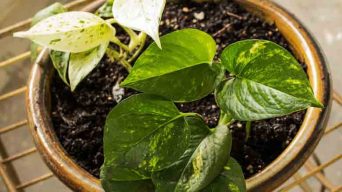Pothos plants are a type of houseplant that is known for being easy to care for. They can tolerate lower light conditions and are forgiving if you forget to water them occasionally.
Pothos plants are also one of the fastest-growing houseplants, so if your pothos is growing slowly, there might be a reason why.
This article will help you troubleshoot why your pothos might be growing slowly and give you some tips on how to make pothos grow faster.
Why Is Your Pothos Growing Slowly?
There are a few reasons why your pothos might be growing slowly.
If you can rule out these potential problems, you’ll be one step closer to getting your pothos plant to grow faster.
Not Enough Light
Pothos plants rely heavily on light to thrive and grow properly.
When you do not provide the plant with enough light, its growth will be stunted, and it may even become weak or damaged.
The lack of light can interfere with the plant’s ability to produce energy through photosynthesis, preventing it from producing sufficient sugars and nutrients to fuel healthy growth.
Additionally, a lack of light can make it difficult for the pothos to produce chlorophyll, which is essential for delivering energy to other parts of the plant.
If you think your pothos needs more light, try placing it in a brighter location.
You may also need to supplement the natural light with artificial lighting, such as grow lights.
Too Much Water
Water is essential for healthy plant growth, and pothos plants are no exception.
However, too much water can be problematic, as it can cause the roots to rot and the leaves to fall off. This happens because the excess moisture can block the nutrient uptake necessary for healthy plant growth.
Additionally, too much water makes the soil more acidic, which can stunt root growth and reduce the overall health of your plant.
So if you want your pothos to grow quickly and thrive, it’s essential to be careful not to overwater it.
You can avoid overwatering your pothos by checking the soil before watering it.
You don’t need to water the plant if the soil is already moist.
It’s also a good idea to use a well-draining potting mix and to make sure that the pot has drainage holes so that excess water can drain out.
Too Little Water
Pothos plants are known for their resilience and ability to thrive in various conditions.
However, like any plant, they need adequate levels of water and nutrients to grow and flourish.
If you fail to adequately water pothos plants, they will show signs of stress as their leaves begin to droop and their growth slows down.
This is because, without enough water, the roots cannot take up the nutrients necessary for healthy growth processes.
As a result, the lack of water interferes with the plant’s critical metabolic processes, slowing its overall growth rate.
Paying attention to your pothos plant’s watering needs can help ensure that it grows successfully and maintains its beautiful appearance over time.
Nutrient Deficiencies
Pothos plants need a wide range of nutrients to grow properly and stay healthy.
The essential nutrients for pothos plants include nitrogen, phosphorus, and potassium.
These nutrients are essential for the plant’s leaves, roots, and overall growth.
If your plant is deficient in any of these nutrients, it will likely experience slower growth and may even develop yellow leaves.
A general-purpose fertilizer that contains a balance of these essential nutrients is usually all you need to keep your pothos plant healthy and encourage fast growth.
If you think your plant might be suffering from a nutrient deficiency, you can also get a soil test kit to help determine which nutrients your plant lacks.
Once you know what nutrients your plant needs, you can give it the appropriate fertilizer to encourage healthy growth.
Poor Soil Quality
The quality of the soil can also affect the growth rate of your pothos plant.
If the soil is too dense, it can inhibit root growth and make it difficult for the plant to absorb nutrients.
Additionally, if the potting soil is too sandy, it might not hold enough moisture and nutrients, leading to slower growth.
To encourage faster growth, it’s essential to use a high-quality potting mix that is well-aerated and has good drainage.
You can also add some organic matter to the soil, such as compost or manure, to help improve its quality.
Temperature Stress
Pothos plants are tropical plants and thrive in warm, humid conditions.
However, they can also tolerate a wide range of temperatures and even survive brief periods of cold weather.
That said, prolonged exposure to too hot or too cold temperatures can cause stress to the plant, leading to slower growth.
To ensure that your pothos plant grows quickly, it’s essential to keep it in an environment that has moderate temperatures and high humidity.
Pot-Bound
Pothos plants can become pot-bound when grown in pots that are too small for them.
When a plant is pot-bound, its roots become crowded and begin to wrap around the inside of the pot.
This can impede the plant’s ability to absorb nutrients and water, leading to slower growth.
Pot-bound plants are more likely to experience stress and may even die if they are not repotted promptly.
To prevent your pothos plant from becoming pot-bound, choosing a pot that is large enough for the plant to grow comfortably is crucial.
As a general rule of thumb, you should choose a pot 2-3 times the size of the plant’s current pot.
How To Make Your Pothos Plant Grow Faster
If you want to make your pothos plant grow faster, you can do a few things.
Following the tips in this article can help ensure that your plant grows quickly and stays healthy.
1. Fertilize Properly
Fertilizing your pothos regularly can help to promote faster growth and a healthier plant. This is because fertilizers provide nutrients your plant needs to thrive, such as nitrogen, phosphorus, and potassium.
Additionally, regular fertilizing helps to stimulate the production of new leaves and stems within the plant.
When you feed your pothos regularly with a rich fertilizer, you provide essential nutrients that allow it to grow quickly and efficiently.
A good rule of thumb is to fertilize every two weeks during the growing season and every month during the winter. Use a balanced fertilizer that contains nitrogen, phosphorus, and potassium.
Be careful not to overfertilize, as this can burn the roots and damage the plant.
2. Prune Regularly
Pruning your pothos regularly can also help to encourage faster growth. This is because pruning helps to stimulate new growth within the plant.
Additionally, pruning can help keep your plant tidy and compact, encouraging faster growth.
To prune your pothos, cut back the stems to the desired length using a sharp knife or pair of scissors. Make cuts just above a leaf node (the point where leaves grow) to encourage new growth.
Use pruning shears to cut back the stems, and be sure to sterilize them between cuts to avoid spreading disease.
3. Water Deeply and Allow the Soil to Dry Out Between Waterings
Proper watering is essential for all plants, and pothos is no exception. Water your pothos deeply, but be sure to allow the soil to dry out between waterings.
Watering deeply encourages the roots to grow into the soil, resulting in a stronger plant that is better able to withstand drought and other conditions. Water thoroughly until water begins to drain from the bottom of the pot.
Allow the soil to dry out completely before watering again. This will help to prevent overwatering, which can lead to root rot and other problems.
4. Place Your Pothos in Bright, Indirect Light
Pothos do best in bright, indirect light. This means placing them near a window where they will receive plenty of light, but not direct sunlight.
Direct sunlight can scorch the leaves and cause the pothos plant to become leggy and stretch out (etiolated).
East- or west-facing windows are typically the best places to put pothos plants. You can also use grow lights if you need a window with enough sunlight.
5. Keep Your Pothos Plant Warm
Keeping your pothos warm is essential in promoting overall growth and health. This is because pothos are tropical plants that thrive in temperatures between 60-80 degrees Fahrenheit.
If you are looking to grow your pothos faster, you will need to provide it with a warm, comfortable environment that allows it to focus its energy and resources on growing strong and healthy.
One way to do this is to place your plant in a warm room in your home, such as the kitchen or living room.
Keep your plant away from drafts, heaters, and other extreme heat or cold sources.
6. Increase Humidity Around Your Pothos
Pothos plants thrive in humid environments. This means that increasing the humidity around your plant can help to encourage faster growth and a healthier plant.
There are several ways to increase the humidity around your pothos, such as using a humidifier or placing the pot on a tray of pebbles and water. This will help to create a microclimate that is ideal for pothos growth.
Additionally, you can mist your pothos regularly with water to help increase the humidity around it.
7. Use the Right Soil
Using the right soil is another important factor in promoting fast pothos growth. Pothos prefer well-draining, slightly acidic soil.
One way to ensure that your pothos has suitable soil is to mix it yourself using equal parts potting mix, perlite, and peat moss. This will create a light, well-draining soil perfect for pothos plants.
If you do not want to mix your own soil, you can purchase a pre-mixed potting mix designed for tropical plants. Just be sure to check the ingredients list to make sure it contains perlite or another drainage material.
8. Repot as Needed
As your pothos grows, it will eventually outgrow its pot. When this happens, you must repot your plant into a larger pot.
Repotting not only gives your pothos more room to grow but also allows you to refresh the soil and add nutrients that can help encourage faster growth.
When repotting, be sure to use a pot that is only slightly larger than the previous one. This will help prevent your pothos from becoming rootbound, leading to slower growth.
Additionally, be sure to use fresh, well-draining soil when repotting. This will give your pothos the necessary nutrients to continue growing strong and healthy.
It’s recommended to repot pothos every 12-18 months.
9. Keep Your Pothos Free From Pest Infestations
Pest infestations can cause severe damage to pothos plants and lead to slower growth. Common pests that attack pothos plants include mealybugs, aphids, scales, and spider mites.
Mealybugs and aphids are particularly damaging because they feed on the sap of the plant, which can lead to stunted growth. Scales and spider mites can also cause damage by sucking the nutrients out of the leaves.
If you notice pests on your pothos, you must take action immediately.
There are several ways to get rid of pests, such as using insecticidal soap or neam oil. These are safe and effective methods that will help to protect your pothos from further damage.
10. Keep Your Pothos Healthy and Free from Diseases
Pothos are susceptible to various diseases that can cause slow growth or even death. The most common diseases that affect pothos plants include root rot, leaf spot, and powdery mildew.
Root rot is a severe disease that can kill your plant if it’s not treated promptly. Leaf spot and powdery mildew are less serious but can still cause damage to your plant if left unchecked.
The best way to prevent diseases is to keep your pothos healthy. This means providing the right amount of light, water, and nutrients. Additionally, you should avoid overwatering, as this can lead to root rot.
If you notice any signs of a disease, such as yellowing leaves or brown spots, it’s crucial to take action immediately. The sooner you catch and treat the disease, the better chance your plant has of surviving.
You can treat diseases with various methods, such as using fungicides or treating them with a homemade solution, such as baking soda and water.
How Fast Do Pothos Plants Grow?
Pothos plants are fast-growing plants that can reach up to 30 feet. However, the rate at which they grow will depend on various factors, such as the type of pothos, the growing conditions, and how well they are cared for.
Pothos plants grown in ideal conditions can grow up to 12 inches per month. However, if they are not given the proper care, they may only grow a few inches yearly.
No matter how fast or slow your pothos grows, it’s essential to give it the proper care to ensure that it remains healthy and continues to thrive.
Final Thoughts
Pothos are easy-to-care-for plants that make great additions to any indoor space. Pothos is an excellent option if you’re looking for a plant that grows quickly.
By following the tips above, you can encourage faster growth and ensure that your pothos remains healthy and thriving.
With proper care, your pothos can grow several inches each year.
With patience and some TLC, you’ll have a beautiful, lush plant that adds life to any room.







